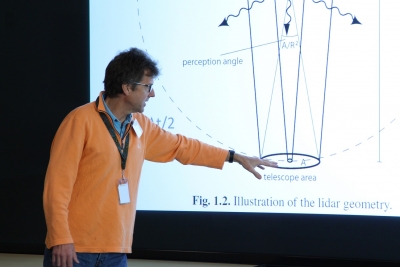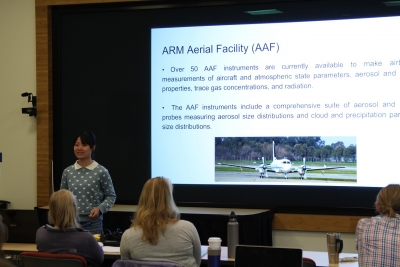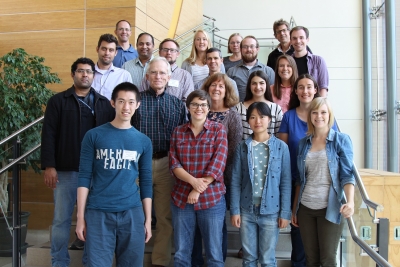ARM in the Classroom: University of Washington Students Explore Atmospheric Instrumentation
Published: 23 October 2017
ARM staff and users teach the inner workings of sophisticated hardware
Studying atmospheric sciences at the University of Washington (UW), Sam Pennypacker analyzes ARM Climate Research Facility data from the Azores and Ascension Island for his research in aerosol-cloud interactions. But learning about the instruments providing that data can be difficult from a distance.

That’s why Pennypacker, a third-year graduate student, jumped at the chance to take a two-week instrumentation short course with nine other UW students in September at Pacific Northwest National Laboratory (PNNL). The course was taught by PNNL scientists and engineers, most of whom are or have been connected to ARM. Focusing on themes such as calibration and accuracy, instructors developed lectures on ground and airborne instrumentation and measurements, data management, and atmospheric chemistry and cloud microphysics.
“I was really interested in getting a chance to learn some of the nuts and bolts of these observations and instruments I was using all the time,” says Pennypacker, whose graduate adviser is Rob Wood, a site scientist at the Eastern North Atlantic (ENA) atmospheric observatory in the Azores. “Learning it from the experts, the instrument mentors, you can’t beat that. You can only get so much from reading documentation.”
The PNNL-UW course was the brainchild of Bob Houze, a PNNL Laboratory Fellow and UW professor emeritus of atmospheric sciences. He has worked on ARM field campaigns, such as the ARM Madden-Julian Oscillation Investigation Experiment on Gan Island (AMIE-Gan) in the Maldives.
“In our department (at UW), we don’t have the observation and instrumentation infrastructure for our students to become acquainted with,” Houze says.

Houze got help organizing the course from Lynn McMurdie, a research associate professor of atmospheric sciences at UW, and PNNL researcher Laura Riihimaki, who makes sense of instrument data as lead translator for ARM.
Riihimaki recruited fellow PNNL staff members to serve as course instructors, worked with them to map out how the coursework would progress, and taught a section.
“I wanted the students to get an idea of the whole end-to-end process from sticking an instrument out in the field to bringing in the data, doing the data quality, looking at what it really means, and then how would you archive it so that people can use it in the future,” Riihimaki says.
The speakers/lecturers included:
- Jennifer Comstock (engineering and science products lead), introduction to ARM
- Riihimaki and Victor Morris (technologist), broadband radiometers/data logging
- Connor Flynn (aerosol instrument translator), spectral radiometers
- Nitin Bharadwaj (radar engineering lead), Joseph Hardin, Brad Isom, and Andrei Lindenmaier (Radar Engineering and Operations Group members), radars
- Rob Newsom (instrument mentor for Doppler and Raman lidars), lidars
- Jason Tomlinson (ARM Aerial Facility engineering manager), aircraft
- John Shilling and Alla Zelenyuk-Imre, chemistry
- Gourihar Kulkarni, ice nucleation/cloud condensation nuclei
- Chitra Sivaraman, Krista Gaustad, Sherman Beus, and Ken Burk (Data Integration Team), data management.

Instructors reinforced their lectures through experiments, demonstrations, and computer analyses. Students even got to design field campaigns based around ARM radars and other instruments.
“We tried to present the students with information that went beyond textbooks and addressed the realities of working with these instruments in a research capacity,” Hardin says. “This is important because these students will eventually be our peers and colleagues in the field.”
The group also toured PNNL’s Atmospheric Measurements Laboratory, a research facility with instruments used to study aerosols, clouds, and their interactions, and ARM’s Gulfstream-1 research aircraft that PNNL operates for the U.S. Department of Energy.
Students will receive credit for the course, but the work isn’t over. They each have a month and a half to complete a project, designed by the student with one of the course instructors, using ARM measurements and PNNL research data.
Check out the ARM Flickr page for photos from the short course.
The ARM Climate Research Facility is a DOE Office of Science user facility. The ARM Facility is operated by nine DOE national laboratories, including Pacific Northwest National Laboratory.
Keep up with the Atmospheric Observer
Updates on ARM news, events, and opportunities delivered to your inbox
ARM User Profile
ARM welcomes users from all institutions and nations. A free ARM user account is needed to access ARM data.


















